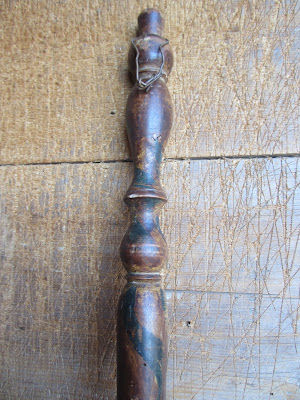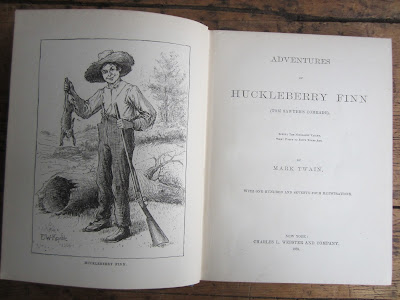The Silver Twin's ...Place...
In New England Decorative Art
Part Seven
"Quasi"
I
would enjoy... and will get to... a brief pontification upon the New England
bed warmer; its design, construction, nuance features and ...a duo of heritage
anecdotes... right along.
Further... I will write my desire to summarize my progress of inspecting
the Silver Twin’s ...Place... in New England decorative art. But first I want to... cable and
drag... New England intellectual ponderance (American Renaissance) ...into my
discourse.
‘Intellectual
ponderance’ I qualify by pushing “quasi” before those two joined words...
making three joined words. I do
not like using quasi but... it is safer to use that word so as to allow old New
England intellectual ponderance a ‘hole out’ (‘escape hole’). This is particularly needed when I
essay about old New England antiques and
The
peoples of them.
It
is a dirty trick I know but allowing one to “quasi-out” by stepping away from
all of this and ‘going to the flea market’ (both physically and intellectually)
IS a “right” (in its many meanings)
That
even I have
In
addition to being... quasi... inclusive... “of all”.
I
end up at the flea market all the time with all of this; “every weekend”. Where are you? I sell old drilled three legged cast
iron fireplace kettles to... no one.
Sap yokes, sap spiles and coffee cans full of wooden clothes pins
find... no one taking them home.
Even
as decoration. A bed warmer is too
confusing; no one knows “What that is”.
“Oh.” And I do have them around... ‘if
needed’.
Did
Thoreau use a sap yoke (starting in Part Three). Have one? Make
one?
Did
Thoreau make a sap yoke? Once...
in his life.
At
his homestead? With his hatchet.
What
about sap spiles? (Part Two)
Did
he use a bed warmer? Did he HAVE a
bed warmer. Or did his FAMILY have
a bed warmer that he ‘saw’ from ‘childbirth to death’ “over there; next to the
fireplace... hanging” (Part Six).
Am I suggesting an intensive examination of Thoreau’s journals...
including all printed and published versions but defaulting back by necessity
to critical examination of the actual journals (due to printed and published
“omissions” [so called]... to determine if
Henry
David... noted (noticed) a cast iron three legged Colonial Era fireplace
cooking kettle (Part Five) and... ANY OTHER ‘such and such’ (old New England
Decorative Art) “ANTIQUES”. Now
the reader is clear as to why I cabled and dragged the word ‘quasi’ on to
this... cabled and dragged ‘intellectual ponderance’?
Yes
you are because Henry David turned the kettle over outside the Walden hut in
late November so it would not ‘crack’ when it ‘froze’ after being ‘used’ as a
flower pot before the Walden hut “all summer” and after
He
drilled it (June journal entry note:
“Today I drilled my fireplace cooking kettle”, etc. ?) ‘so it will
drain’ ‘last June’. That
(‘drilling to drain’ Part Five) is in the journals? No... I have brought you the word ‘quasi’ for the ‘like
this’... of Old New England Decorative Art. And you see where I’ve gone with it.
Thoreau’s
sister “presented” the family’s Concord made Patent Banjo Timepiece (clock) to
the Concord Museum. They still
have it. It is beautiful and
wonderful. “What’s that?” you
say. These; this presented
timepiece, the presenting family, the museum and the low-cal (Concord) are...
therefore... ‘at the flea market’ in all of this when “What’s that?” (a “YOU”)
comes to “SEE” the “THE CLOCK”.
The flea market is the third word of old New England Decorative Art. It is “quasi”. It creates a (quasi) “old” “clock”...
that no one knows about... let alone pays admission ‘to see’.
“Quasi”: You can bank it.
“Quasi”
is the word that trumps even ‘decoration’... in the study of old New England
Decorative Art.”
Did
I just say “study”? Maybe that
would be easier as “quasi study”.
Autumn. The bed warmer’s lathe turned hardwood
(maple) handle more often then not was finished with rapid single color paint
brush strokes (green or red) as decoration upon the handle. Two hundred years later these old
paintings are hard to notice for they are oxidized and worn ‘away’. They are there and the
know-to-look-for-them eye easily denotes them. This denotation assures ‘authentic’ ‘first surface’
(original surface) ‘handle’. Should this decoration be vibrant... then it is best to be
suspect that this vibrant painting was recently done. That too should be carefully considered if there is abundant
painting that is ‘too well done’.
The original old paint was done by an eight or ten year old boy painting
as fast as he could. It should
look like that.
The
old surface of the wood should look like that too; an old surface. No ‘oiling’. No varnish. No.
Wear
(worn paint and surface finish) should be where the hands held the pan when
using it. Other surface areas were
‘left alone’. Always. They look like that; old left alone.
The
brass ‘pans’ usually have been “once” “old” “polish”. That is what happened to the brass pan: It was ‘used’ (filled with embers to
heat the beds) and ‘polished’.
That is what happened
To
the bed warming
Pan.
Notice
the hinge (‘cover joint’), handle socket and ‘turned’ (finished-flared) edge of
the pan to receive the lid. The
lid has a tiny hoop hook to lift it open.
It has, too, ‘chased’ decoration... ranging in quality (effort) from
‘plain’ to ‘fancy’ and ‘pictorial’.
The lid folded back on the
handle. Then was closed once the
embers were in. Not too many
embers... did the job. This was
not “carrying fire”. It was hot...
but not that hot... and certainly not “fire”. The pan returned to the fireplace, the embers returned to
the fire and... ‘was hung (back) up”.
Quickly, quietly, every night, all winger long. It did not smoke, it did not ‘smell’
and the house did not get burned down from doing this. “FIRE” was a prominent... and very well
managed aspect of domestic old New England. Open flames were “everywhere”. Very little “burned flat”. “Children” were “good” “with fire”. Too. When did New England stop using bed warmers? I hope to find the answer through my
study... quasi study... of Thoreau’s journals... at the flea market.
Winter: The up hill (starting Part One)...
resulting from the down hill... left alone
The ‘made there’.
But... all of these things
Stayed
there;
At
the homestead.
They
were used, put away and left alone.
Then they became a ‘still there’ when I noted them (‘found them’).
When
I took them...
From
there.
By
the time I reach the bottom of the hill with my truck loads of... old beds,
wooden buckets, window frames of ‘old glass’, hanging match holders, gilt gold
looking glasses, old handle lost adze blades, maker marked drawshaves, pottery
basins, ladder back chairs, farm animal salt boxes, old kitchen chair tables,
trunks full of mouse leavings, a visitor’s candle lantern, religious books
(“dogmatic theology”) and ...old blade worn bread knives...
All
of it is a lost soul. But that doesn’t matter
At
the flea market.
When
they are looking at the looking glass they never look THROUGH the looking
glass?
Pretty
much. So I don’t have to sell it
to them. Eventually someone ‘wants
it’
“For
what?”
I
don’t really want to know. They
tell me anyway; “Just the right spot (size, shape, form, place and, of course,)
“After I fix it”.
Used,
put away, left alone. Is behind it
(the looking glass). Now. In its few seconds left of it being
‘that way’ (the way I found it) I passively return to my hand’s reach to its
top in the dark on the pine wood paneled wall beside the fireplace where it had
been ‘tucked in hiding’ for... so long ago that no one can remember anyone ever
looking in... or through... that looking glass...
Can
I.
Then
it is gone (sold); all of it.
Sometimes, decades later, I find a such and such as this before me
again... and it is “still” ‘just the same’. Sometimes I even buy this ‘just the same’ and ‘sell it’...
again. And again... and again... I
see my hand’s reach ... in the dark... where it is still ‘tucked in
hiding’. In my mind. I didn’t spend forty years finally
figuring out the ‘this’ of ‘this’.
No. I got it early on; the
‘this’ of ‘this’.
I
found out exactly what I wanted:
What... I... wanted. And
stayed there ever since. I wanted
a certain expression... that is as if a... certain breeze... whispering: A certain expression of a certain
breeze that comes whispering.
This, these days, is hard to find.
This ‘hard’ includes ‘quasi-hard’ to find too. I might as well include that for I see the ‘quasi’ of
antiques all the time.
The
two antidotes are simple enough. I
have used both in my writings (blog posts) before... although the contexts were
different. I couldn’t tell the
reader what writings they are in.
I have no index. It doesn’t
matter; the two jewels are real jewels.
The
first is the legend-legacy-tale that the Newburyport merchant-poet Timothy
Dexter (and his missive masterpiece “A PICKLE FOR THE KNOWING ONES”) was
skylarked by his local merchant fellows into purchasing a ship’s cargo of bed
warming pans and ...so there... ‘hung with it’ (the bed warmer cargo). Presumed then to be a ‘loose’ so to
foster his ‘financial decline’... did not occur. Dexter peddled the whole cargo ‘for a fortune’ in the West
Indies to be used as ‘molasses ladles’ by the sugarcane-rum-slave industry.
The
second and notable anecdote is the late in Twain’s HUCKLEBERRY FINN tale (page
322 ) old attic relic retrieval of a bed warming pan by Tom Sawyer and
Huckleberry Finn to use to cook their ‘Witch Pie’. Twain’s snappy words do very concisely affirm all I have
written about the ‘put away’ ‘left alone’ old New England heritage of the
warming pan including it being evident to the reader that Twain himself was a
fellow traveler with the old New England decorative art of the bed warming
pan. He understood its relic realm
and its ‘hung there’ heritages (note plural).





































No comments:
Post a Comment